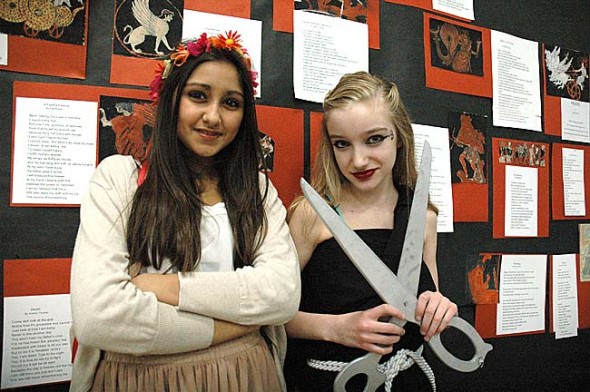
At the district’s project-based learning exhibition night in February 2014, McKinney Middle School students Ischel Heredia, left, and Anastasia Cooper presented the seventh-grade’s Ancient Greece project. The district’s third K-12 PBL exhibition night will take place Thursday, Jan. 15, 6:30–8 p.m. at Mills Lawn School, featuring a wide variety of projects such as a French cookbook, ecosystem exploration and a performance of “Antigone.” (News archive photo by Matt Minde)
Village schools students focus work on village
- Published: January 15, 2015
One of the major goals of project-based learning in the local schools is student work that impacts and is seen by the wider community. To that end, next week villagers are invited to come to the school to see, hear and ask not only what students from kindergarten through 12th grade have been doing with project-based learning this year but potentially utilize some of the classroom research to improve the Yellow Springs community.
The district’s third PBL Exhibition Night takes place Thursday, Jan. 15, 6:30–8 p.m. at Mills Lawn School.
“If there’s one phenomenon I’d like to see disappear, it’s student work that goes into the basement,” said district Librarian Eli Hurwitz, who is part of the district’s PBL development team. “We’re focusing on something that someone would do something with to change the community — projects that live outside the school.”
Yellow Springs High School students in Brandon Lowry’s chemistry class, for instance, have been trying to apply their skills to tracking radon in the village in an effort to reduce the incidence of cancer caused by the toxic gas. The class is testing radon levels in different parts of the village and creating a map of the results that local families could use to assess their risk of exposure.
“Students taking their research to the town to be used — that’s the kind of projects we want,” Hurwitz said. “High quality project-based learning is something that emulates adult work.”
A different project with a more cultural community impact is the musical production Mills Lawn third-grade students will share based on the book, “Why Mosquitoes Buzz in People’s Ears.” According to Nyekeira Thomas, the “pourquoi” story concerns a mosquito that tells a lie to an animal of the forest and begins a cascade of events that results in the death of a baby sun bird. When the grieving mother sun bird doesn’t wake the sun, Paxtyn Jordan said, king lion discovers the mosquito’s fault, and the insect is compelled by guilt to buzz around asking for forgiveness.
Students helped translate the West African folk tale written by Verna Aardema and illustrated by Leo and Diane Dillon into a script, imagining the moves and sounds of the animals they play and making costumes for the sun bird, the agama lizard and the mandrill monkey characters. The students in Peg Morgan’s class had fun learning their songs and rehearsing, they said this week, and are excited to be able to share their work with the community.
Owen Martin learned from the project that just one event “can cause a whole chain reaction,” he said. And Sam Miller learned that “theater is not easy — it’s hard to set up, and you have to practice a lot.”
Other projects to be presented at exhibition night include a high school business class demonstrating their use of math skills to market and sell school spirit wear, a McKinney Middle School multi-media presentation of the school yearbook in draft form, ninth-grade graphic novels based on local historical figures, and a first-grade project demonstrating exploration of the five senses through the question, “What is observation?”
The district is currently in its second year of implementing a project-based learning model into the K-12 curriculum, a change that was prescribed by the district’s 10-year strategic plan. Teachers have received ongoing training from model schools High Tech High in San Diego and the Dayton Regional STEM School, appointed their own internal PBL coaches and dedicated about two Wednesday mornings per month to teacher PBL planning time. The efforts have paid off, according to Hurwitz, who said that while the process isn’t perfect yet, the training and collaboration have greatly improved the projects and helped to increase engagement for all students and deepen the learning experience.
Twenty years of research on PBL, collected by Edutopia (funded mainly by the George Lucas Educational Foundation) and the Buck Institute for Education, a PBL training nonprofit organization, has demonstrated that students who learn through PBL have greater content retention, develop stronger collaboration skills and experience less disparity in education.
Instead of evaluating schools purely on test grades, projects communicate to the school and wider community exactly what and how students are learning, Hurwitz said. And exhibition nights allow that audience to give feedback to teachers and students, potentially improving the projects and the learning.
The projects are meant to be designed by the students based on a contemporary question or problem they have distilled from their academic studies.
“If we can teach our students to be critical thinkers — to look at a problem and be able to come up with a solution on their own, that’s more valuable than remembering a timeline of some old war — especially if that knowledge can be looked up on a computer,” Hurwitz said. “If all that’s involved in learning is memorizing for a test, it’s going to hurt the kid; but if they can do that while being deeper thinkers and helping the community, that’s much more beautiful.”
The Yellow Springs News encourages respectful discussion of this article.
You must login to post a comment.
Don't have a login? Register for a free YSNews.com account.













No comments yet for this article.